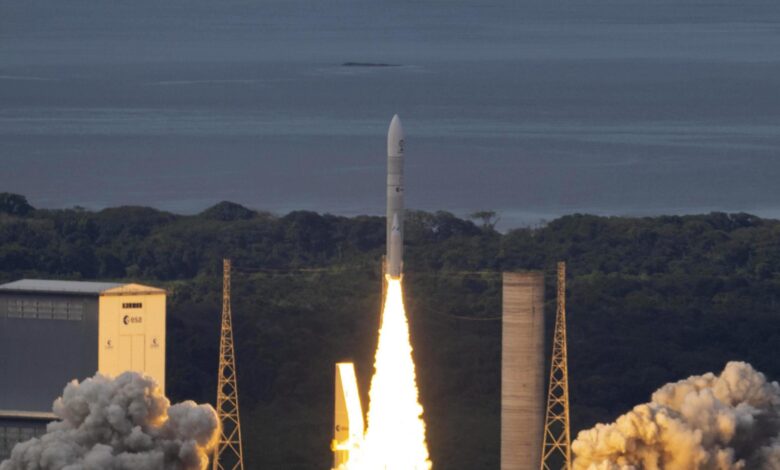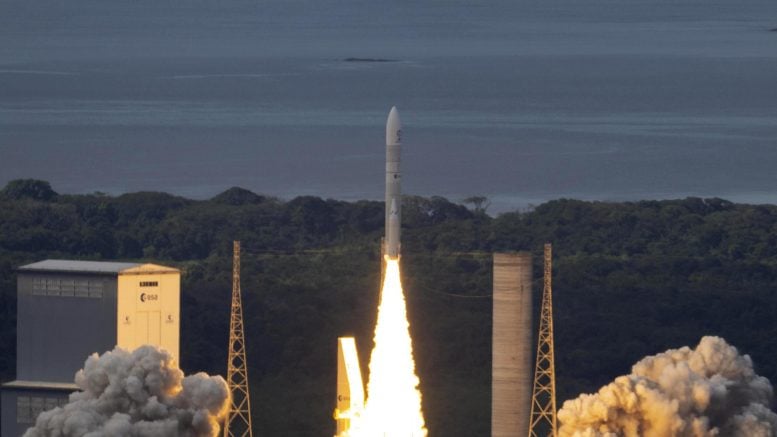Ariane 6 Ignites a New Era in Next-Gen Space Launch Technology


Ariane 6 launches to the sky on July 9, 2024, from Europe’s Spaceport in French Guiana. Credit: ESA – S. Corvaja
Ariane 6, Europe’s new heavy-lift rocket, made its inaugural flight from Europe’s Spaceport in French Guiana at 16:00 local time on July 9 (20:00 BST, 21:00 CEST).
Ariane 6 is the latest in Europe’s Ariane rocket series, taking over from Ariane 5, and featuring a modular and versatile design that can launch missions from low-Earth orbit and farther out into deep space.
“A completely new rocket is not launched often, and success is far from guaranteed. I am privileged to have witnessed this historic moment when Europe’s new generation of the Ariane family lifted off – successfully – effectively reinstating European access to space,” said ESA’s Director General Josef Aschbacher.
Triumph of European Space Innovation
“An inaugural launch is a huge undertaking from thousands of people who have worked relentlessly for years. To see it perform wonderfully at the first attempt is testament to their dedication and a demonstration of European excellence in engineering and technology. Heartfelt thanks go to the teams at ESA, CNES, ArianeGroup, and Arianespace for their hard work to get to this point. I also want to sincerely thank our Member States for having enabled and supported the Ariane 6 program along the way. Not always easy, but the endurance shown has paid off handsomely today.”
This inaugural flight, designated VA262, is a demonstration flight whose aim is to show the capabilities and prowess of Ariane 6 in escaping Earth’s gravity and operating in space. Nevertheless, it had several passengers on board.

Installing payloads on Ariane 6 at the encapsulation hall in Europe’s Spaceport, French Guiana, 4 June 2024. From established players like NASA to students designing their first-ever satellite, these missions will measure gamma rays, track wildlife, test self-healing solar cells, confirm the theory of black body radiation, and more. There’s a smart-farming satellite, a radio beacon demonstrator, experiments that will remain attached to the rocket’s payload ‘adaptor’, and even capsules destined to reenter Earth’s atmosphere to test new materials – Ariane 6’s first flight will be packed with technology as its first payloads are sent on their way into space. Credit: ESA/ArianeGroup/Arianespace/CNES
Successful Deployment and Future Prospects
At 21:06 BST, 22:06 CEST, one hour after liftoff, the first set of satellites on board Ariane 6 were released from the upper stage and placed into an orbit 600 km above Earth. Satellites and experiments from various space agencies, companies, research institutes, universities and young professionals were included on this inaugural flight.
In addition to the rocket, the liftoff demonstrated the functioning of the launch pad and operations on the ground at Europe’s Spaceport. The new custom-built dedicated launch zone was built by France’s space agency CNES and allows for a faster turnover of Ariane launches.

Ariane 6 seen from the skies just hours before it lifts-off for the first time from Europe’s Spaceport in French Guiana. With the 90-metre-high, 8200-tonne mobile building rolled back, tanking is ready to begin. Credit: ESA – S. Corvaja
Building Momentum for Ariane 6
On the occasion of the launch, Philippe Baptiste, CEO of CNES, said: “With this first successful launch by Ariane 6, Europe has finally recovered its capacity to access space. Beyond the great emotion I am feeling right now, my first thoughts are for all the teams in Kourou, Paris, Vernon, Les Mureaux, Toulouse, Bremen, Lampoldshausen, Liège, Barcelona, Colleferro, Zürich, and everywhere else in Europe who made this success possible. I would like to acknowledge the commitment of the employees of CNES, ESA, ArianeGroup, Arianespace and our subcontractors. The last few months have been intense, and I would like to thank them all. Europe can be proud of its space program, Europe can be proud of its knowledge and expertise. Together, let’s prepare the future of launchers and space.”

Artist’s view of European Space Transportation systems. Shown here is the Ariane 6 (A62) two booster launcher in Flight FM1 configuration, to be operated from Europe’s Spaceport in Kourou, French Guiana. Ariane 6 provides a modular architecture using either two boosters (Ariane 62) or four boosters (Ariane 64), depending on the required performance. Credit: ESA – D. Ducros
Ariane 6 was built by prime contractor and design authority ArianeGroup. “With the successful first flight of Ariane 6, the European space industry has moved into a new era,” said Martin Sion, CEO of ArianeGroup. “This historic launch demonstrates the unfailing commitment of our teams and partners, whom I would like to thank warmly for this success, which reflects on the entire European industry. Seeing Europe’s new launcher lift off into space marks the culmination of an outstanding technical and technological adventure, and the beginning of a long history of Ariane 6 operations. The next flight models are already in production and the stages of the second model will be shipped to the Guiana Space Centre this autumn for the first commercial flight of Ariane 6.”

The first flight of Ariane 6 will have three phases, each of which will demonstrate the launcher’s various abilities:
Phase 1 (events 1-5): From ground to orbit
The first phase of Ariane 6’s flight will launch the rocket off Earth and into space with the thrust from the main stage powered by the Vulcain engine together with the force from the two powerful P120C boosters. Phase 1 includes the separation of the main stage from the upper stage and the first boost of the upper stage’s Vinci engine, which inserts it and its passengers into an elliptical orbit 300 by 700 km above Earth.
Phase 2 (events 6-9): Upper stage reignition and satellite deployment
The next phase is when Ariane 6’s newest feature is put to the test: reignition of the upper stage. In phase 2, the Vinci engine will re-fire, changing Ariane 6’s orbit from elliptical to circular. This will be followed by the deployment of the rocket’s eight satellites and the activation of its five onboard experiments.
Phase 3 (events 9-12): Tech demos, deorbiting and capsule separation
The final phase in Ariane 6’s inaugural flight will be to push the cryogenic upper stage to its limits and validate its ability to perform under microgravity conditions. The final phase will initiate the controlled deorbit of the upper stage back through Earth’s atmosphere over the South Pacific ‘NEMO point’, to prevent it from becoming space debris. Moments later, the two reentry capsules onboard will separate from the upper stage, and all three will make their safe descent back home.
Credit: ESA
Continuing the Journey
With the placement of satellites into orbit, Ariane 6 has demonstrated that it can successfully launch its payloads into space, but ground control has more in store for its inaugural flight. Over the next hour, Ariane 6’s upper stage will show again that it can restart its Vinci engine using the novel auxiliary propulsion unit. This restart capability will allow Ariane 6 to drop off multiple passengers into different orbits on future flights and deorbit itself through Earth’s atmosphere at the end of its mission, to ensure it does not become space debris.
On this flight the Ariane 6 upper stage is set to release two reentry capsules as it enters Earth’s atmosphere for a clean disposal to burn up harmlessly, leaving no space debris in orbit.
The next Ariane 6 is planned for launch this year on its first commercial flight under Arianespace as operator and launch service provider. “The success of this first flight marks the start of Ariane 6’s operational career, giving Europe an autonomous access to space,” added Stéphane Israël, CEO of Arianespace. “The new launcher’s order book is proof of the versatility of Ariane 6 and of its capacity to accomplish a wide range of missions into multiple orbits. It reflects the confidence that customers have in Ariane 6 for both their institutional and commercial missions. We are eager to begin operating our new launcher.”




